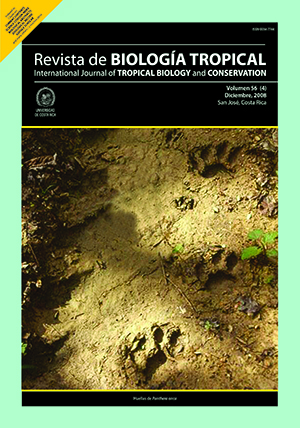Abstract
Gastropod communities associated with the calcareous green alga Halimeda opuntia are described and com-pared for two Puerto Rico coral reefs: one in the northeast with front tradewinds (windward zone) and one in the southwest (leeward zone). We analyzed the content of 21 lots (2432 g) of H. opuntia from leeward zone and 15 lots (2448 g) from the windward zone. In total we recovered 526 gastropods (prosobranchs) classified in 54 taxa. Thirteen species of gastropods represented 79.6% of the community. Differences between species richness and mean density values were not significant (p>0.100). Forty species were identified from leeward and thirty one (31) species from windward. Gastropod mean density was 13.9 /100g of algae in leeward and 7.6/100g in windward. Significant differences were found for the Simpson Diversity Index (0.91 in the leeward and 0.82 in the windward community; t=3.44, α=0.005). We found no correlation between the weight of the algae and the frequency of the gastropods (R2=0.0893 in leeward, 0.0249 windward and 0.0923 for both). The relationship between species composition in lots of windward and leeward study sites was explored via polar ordination and no segregation was found. When compared, the gastropod communities found in H. opuntia col-lected in coral reefs in Puerto Rico were more similar within them than any other communities found in other genera of seaweed and in other environments. Our results agree with the hypothesis that H. opuntia offers the interstitial community a protected microhabitat from water movement impact. H. opuntia creates more homog-enous conditions than those of the habitat where we found the algae.
Comments

This work is licensed under a Creative Commons Attribution 4.0 International License.
Copyright (c) 2008 Revista de Biología Tropical






